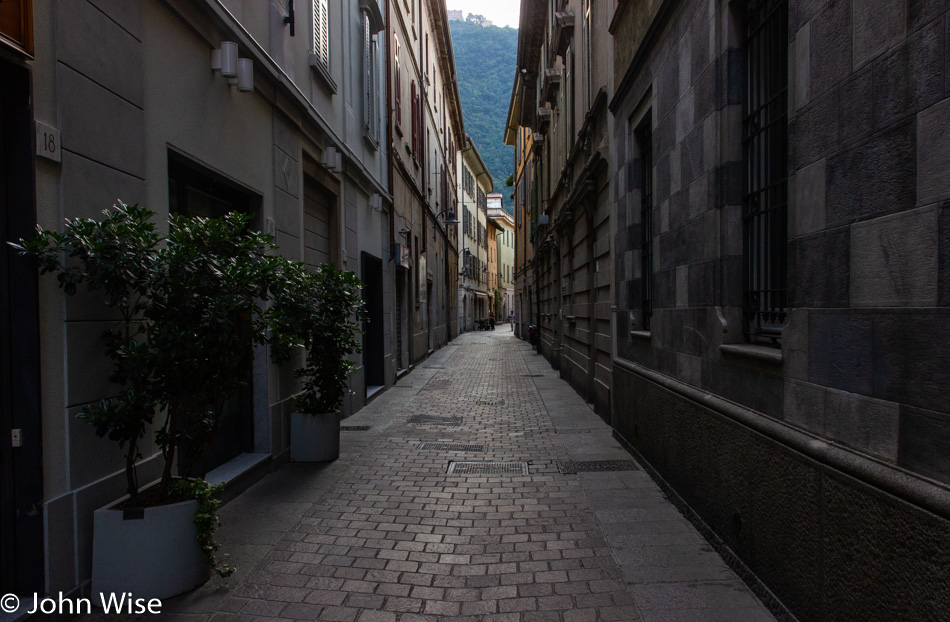
The quiet of a city about to wake is still available to early risers. This is one of the rare moments still available to witness a popular European location without throngs of tourists.
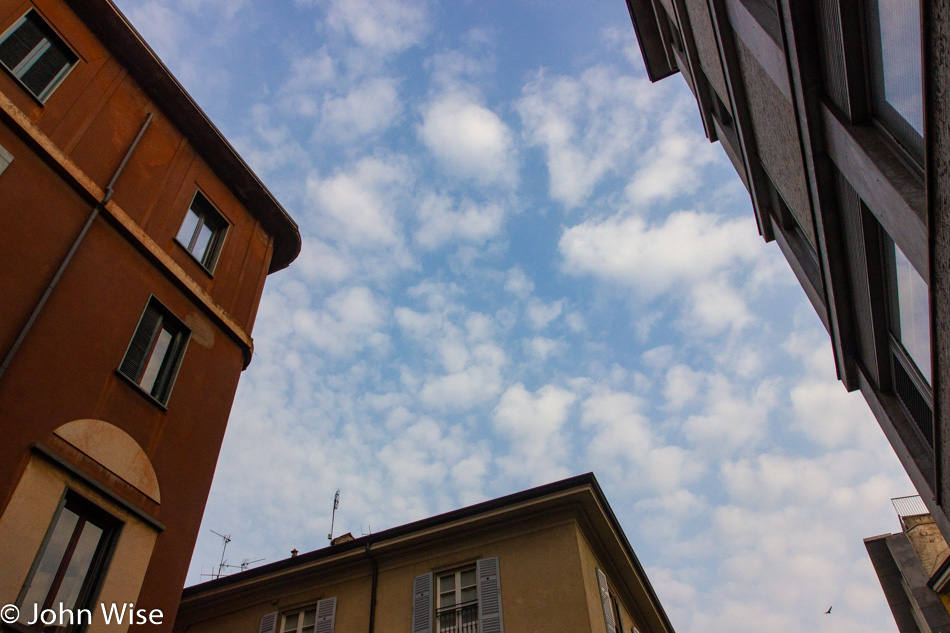
Positive signs of beautiful weather that lend promise of another great day are all around us. These conditions, when the world appears to be all ours, ignite deep memories of special times.
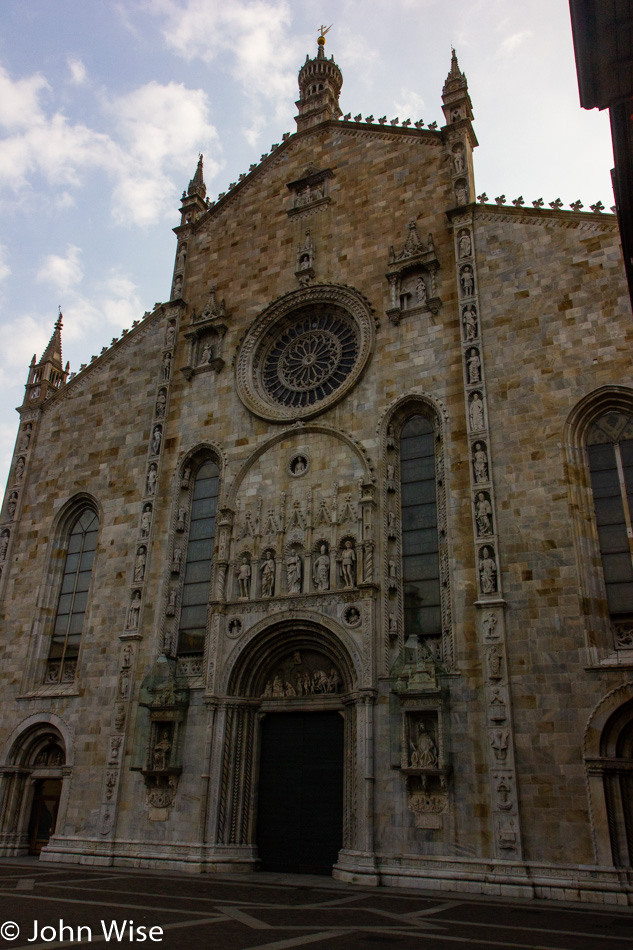
Churches could be seen as massive collections of art and history requiring hundreds of years to reach the cultural focal point they achieved across the centuries. They are important for a sense of community and are rebuilt after fire and wars or even built anew if they are outgrown but still, they persist across the ages.

Nearly every element of the exterior of a church tells a story beyond the obvious ones of it being a place of worship. Where is the stone from, what kind of tiles are on the roof, and how tall is the highest tower? Then you have to look at the gargoyles, statuary, inscriptions, and the overall edifice, which will tell you things about the time the church or cathedral was built and the architectural period.
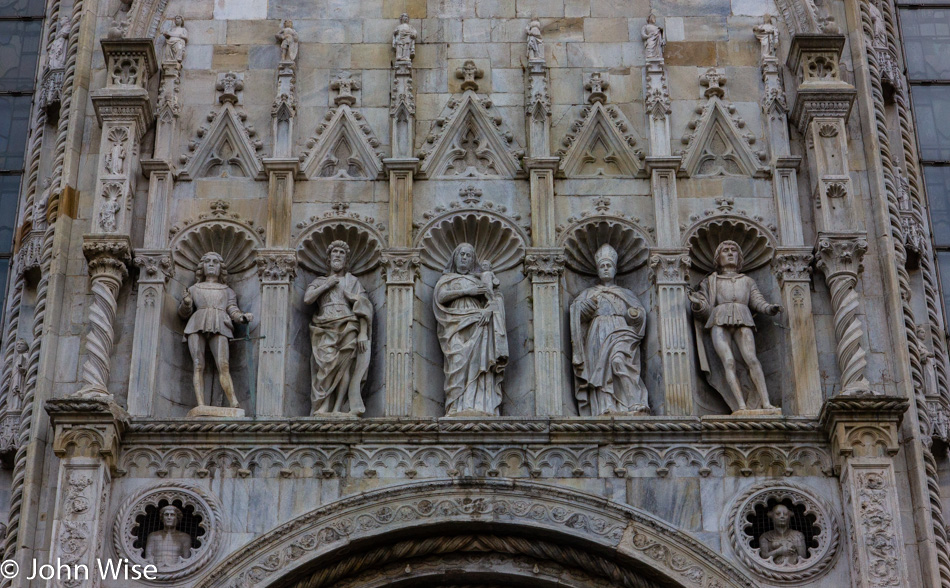
Don’t forget the symbolism and religious iconography that also tell a story that may not be apparent at a glance. Without a docent to guide you and point out these rich details, you may find yourself only able to appreciate the cosmetic beauty of these landmark buildings that were most frequently at the center of the town or next to where the royal family lived.
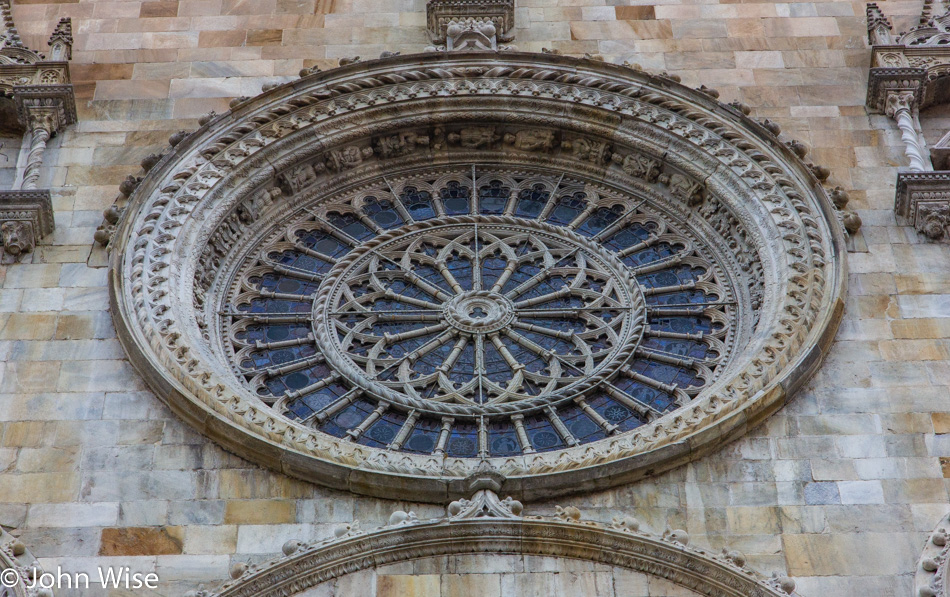
There are millions of tiny details inside and outside a church, not to mention the cultural history and personal relationship of the visitor to ideas of god and how family and friends relate to these institutions, too. The complex entanglement of humanity to religion, be it Christian, Catholic, Jewish, Islamic, Hindu, or Buddhist, all share this deep historical reference within people that binds them across time with their ancestors and future generations.
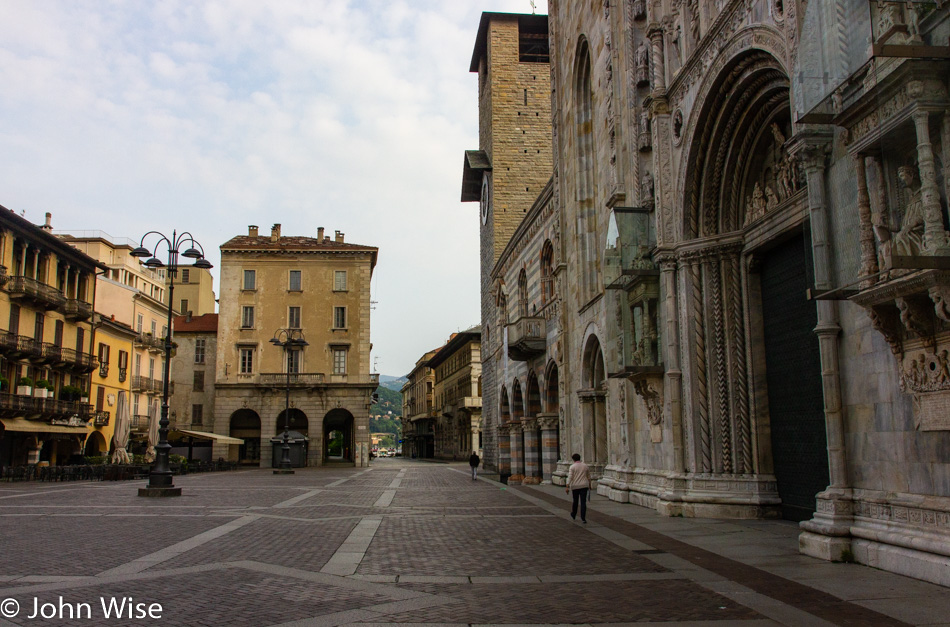
Just outside the church is the village, a kind of symbiotic relationship as if the church is the heart, the village the organs, and the seat of government, hopefully, the brains. The whole becomes society, and upon that, we invent a future laden with our invention, art, and prosperity.
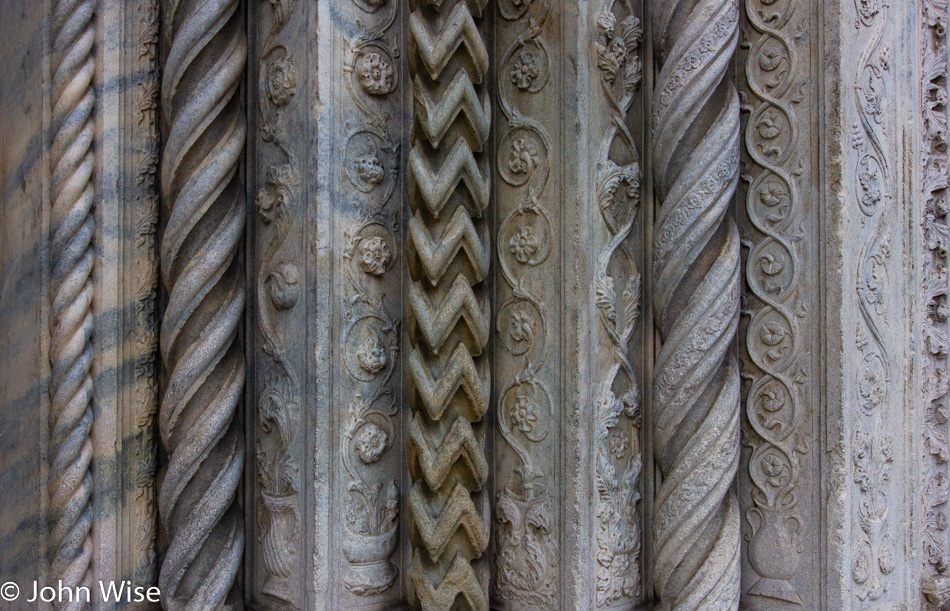
Stamped upon society, government, church, and our future are the fingerprints of all who came before us, often lost in the larger picture. These details are part of the central entry but are only a tiny fraction of what is yet to be discovered.

There is too much to see of even a single cathedral without investing a day, a week, or a lifetime trying to know what is here, and still, you may not have answered the question of how religion might fit in your view.
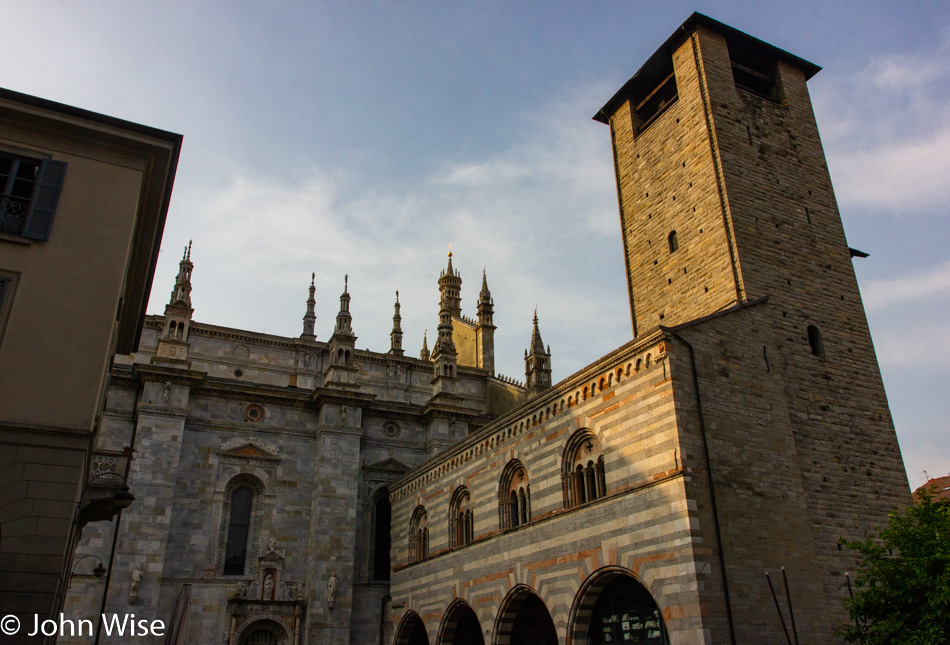
We are still looking at Como Cathedral, just as we have in the previous seven images above this one. Light, weather, season, and time of day also shift our perspective. If just observing a place changes our ability to observe and learn, how is a life long enough to begin to understand the multitude of potentialities that may exist?
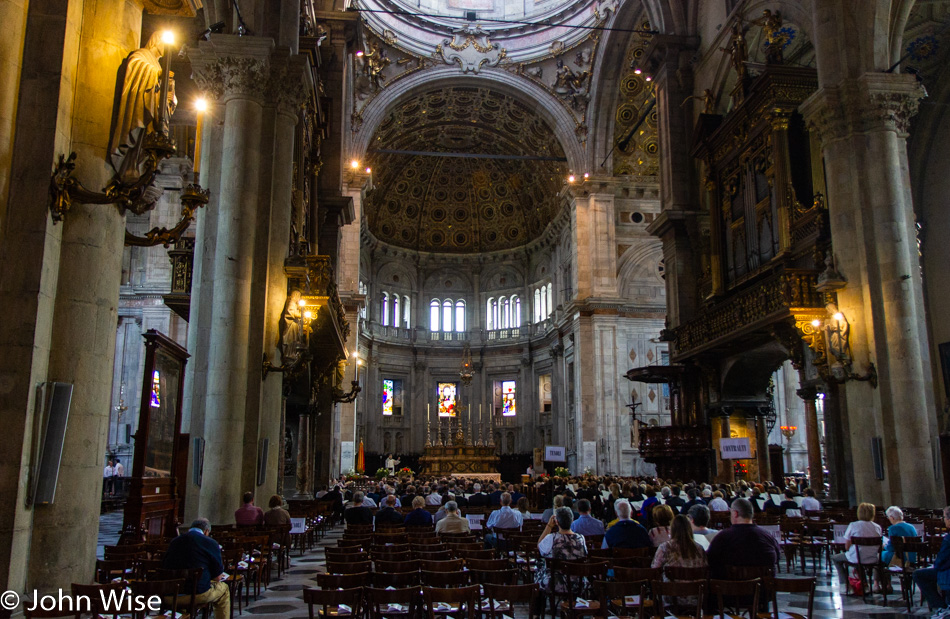
The universe opens anew within the walls of the cathedral as all new details, light, reflection, glow, scent, and sound become known to the visitor. Today, the choir was practicing, and if it weren’t for the fact that we closely joined a family walking in that was known to the person at the door, we wouldn’t have been able to visit the Como Cathedral this morning. Listening to the human voice sing in such a place is a wonder to behold.
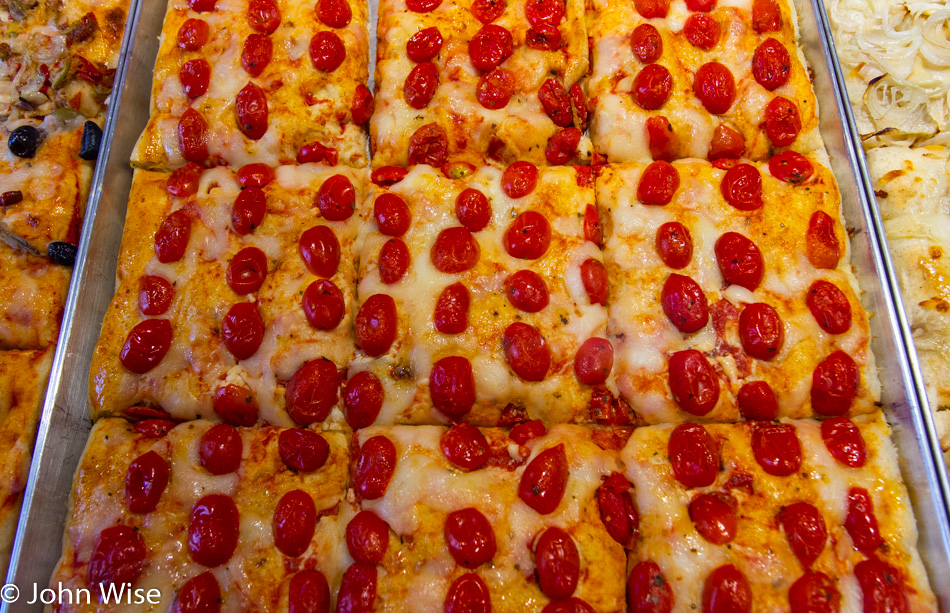
From the temple of God to the temple of food. We needed breakfast by now, and pizza fits the bill.
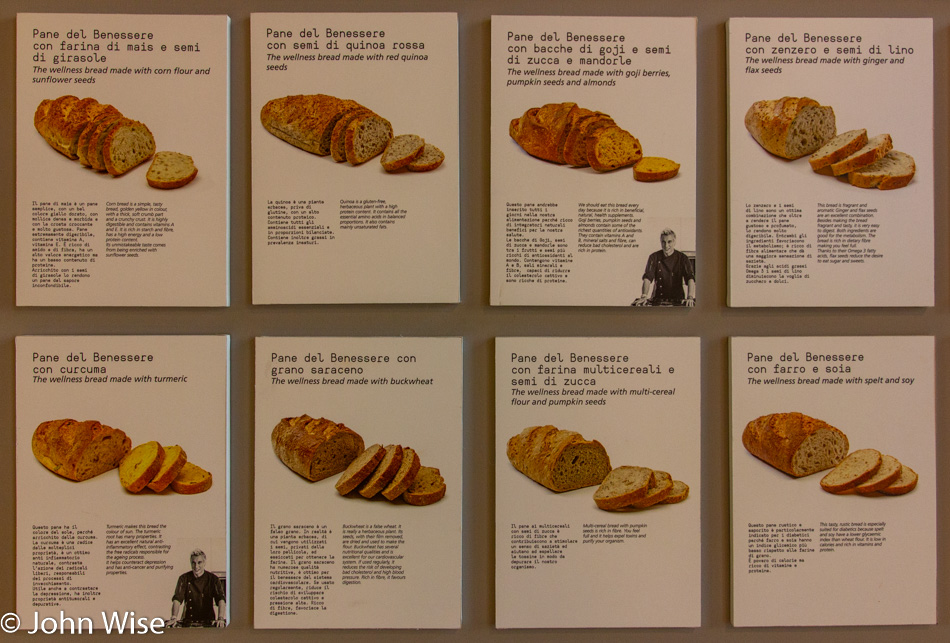
I’m posting these “porn” pictures here for Caroline because, as a German, she has a thing for bread.
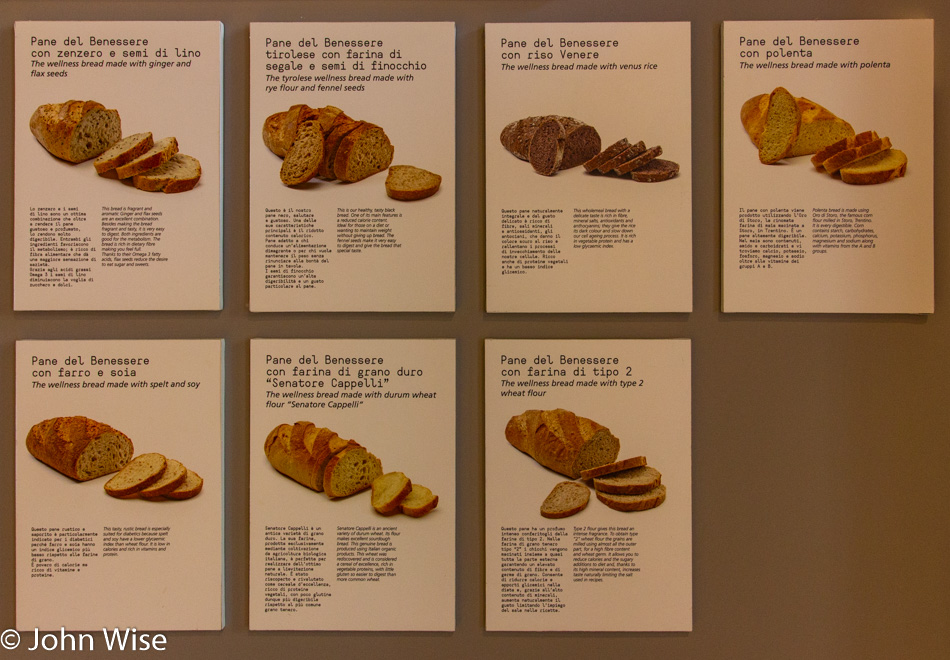
Yeah baby….bread, lots of hot photos of BREAD!

Lake Como is yet another universe to explore. No wonder the wealthy flock to this area.

I’m infatuated with the architecture and in years to come, I may wonder why in the world did I post all these photos of plain old houses. Today, I can answer with the explanation that back in Arizona, the uniformity and conformity of the houses and apartments make for a drab, lifeless environment, which makes everything else all the sexier.
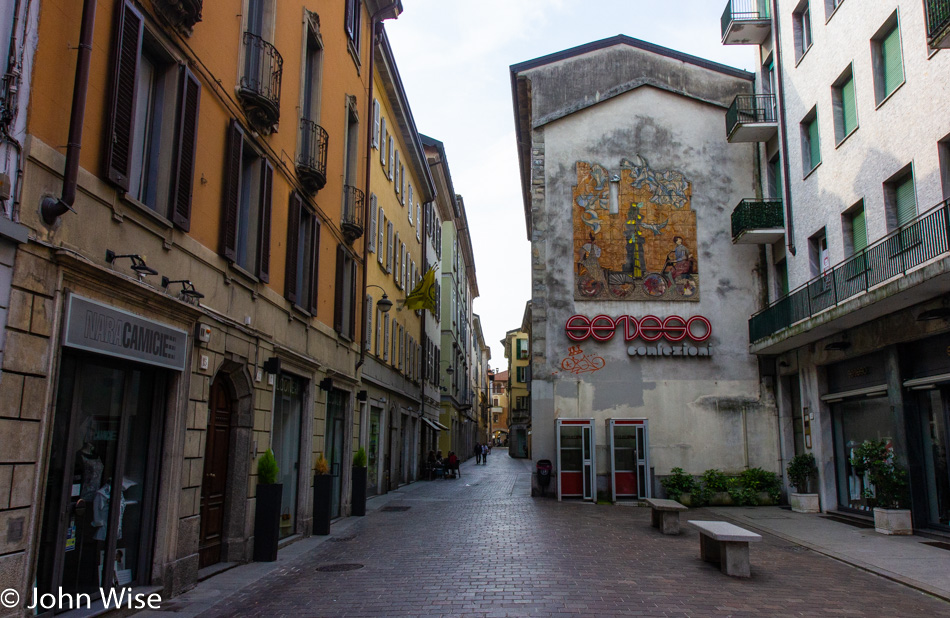
We were seeing payphones frequently, and you’d be hard-pressed to find one in the States these days.

Even the “plain” facades look seriously cool.
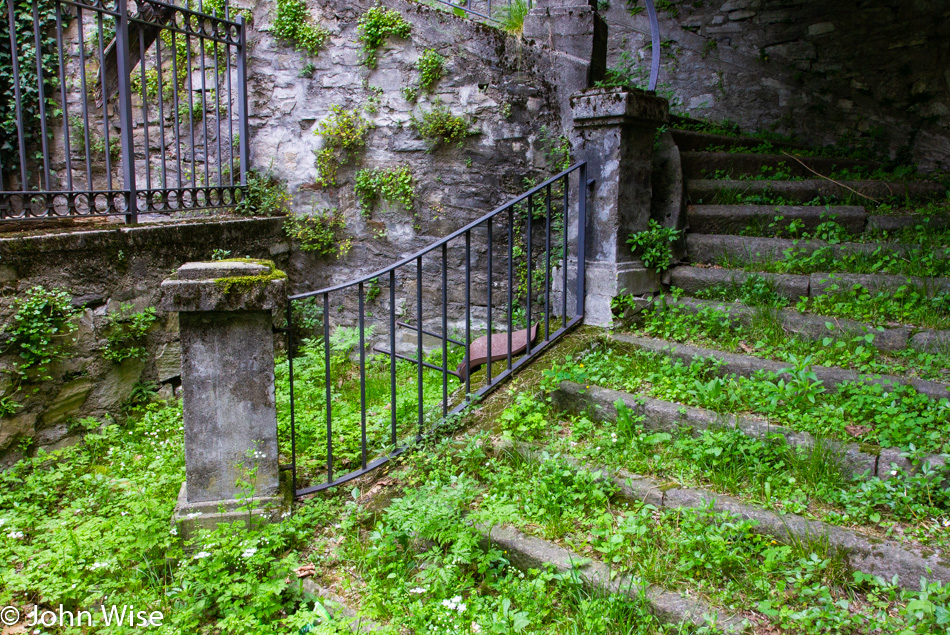
Caesar last walked here.
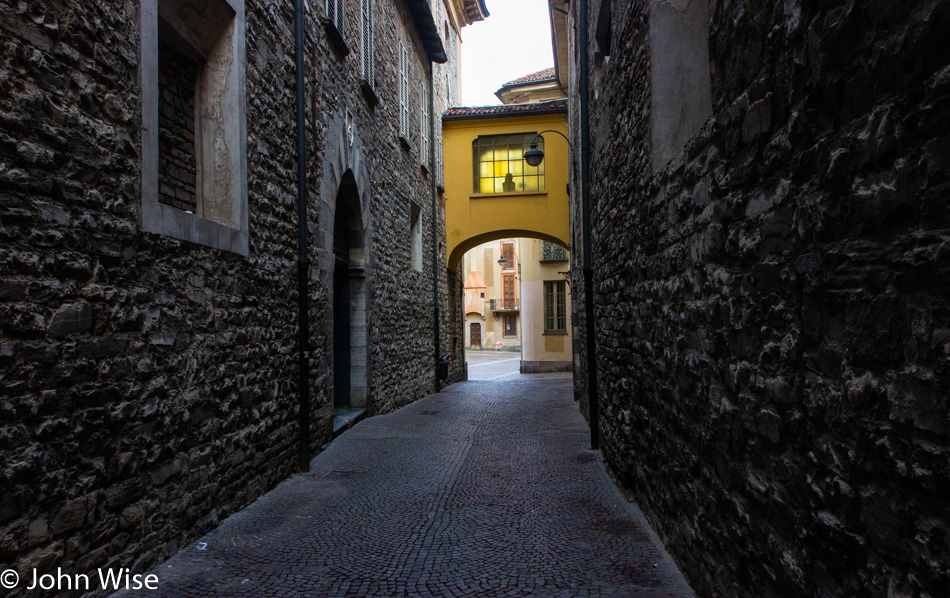
These narrow passageways are heaven to my eyes as there is so much detail to see up close, and the idea of not seeing the full picture of what’s ahead opens the chance that something spectacular might be found around the corner.
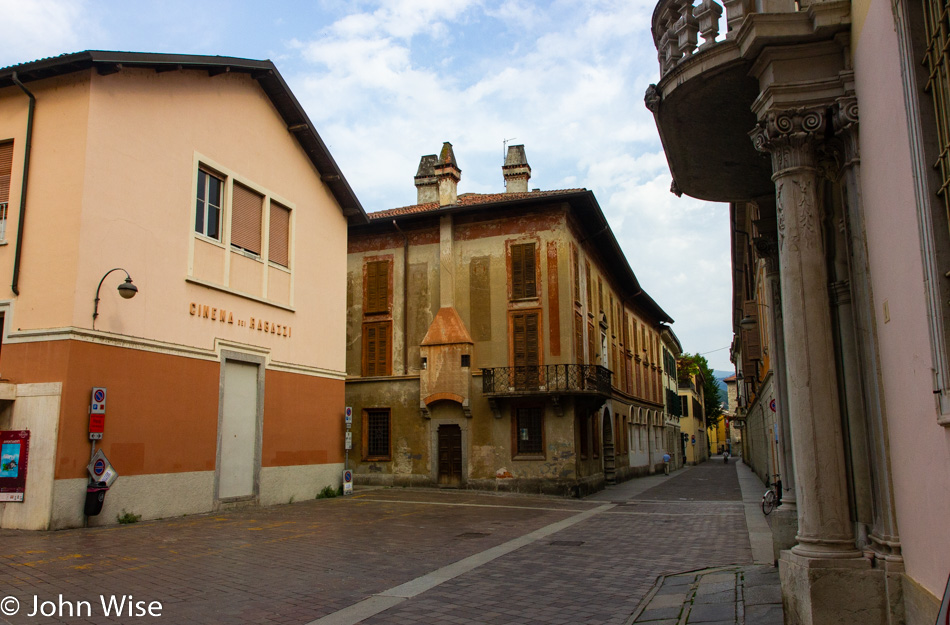
Seeing a building used for the cinema brings me back to Cinema Paradiso, a movie favorite.

Scuffed walls and dirtied sidewalks may not be everyone’s favorite travel photo, but they help rebuild some of those details that would otherwise be lost as overlooked details.
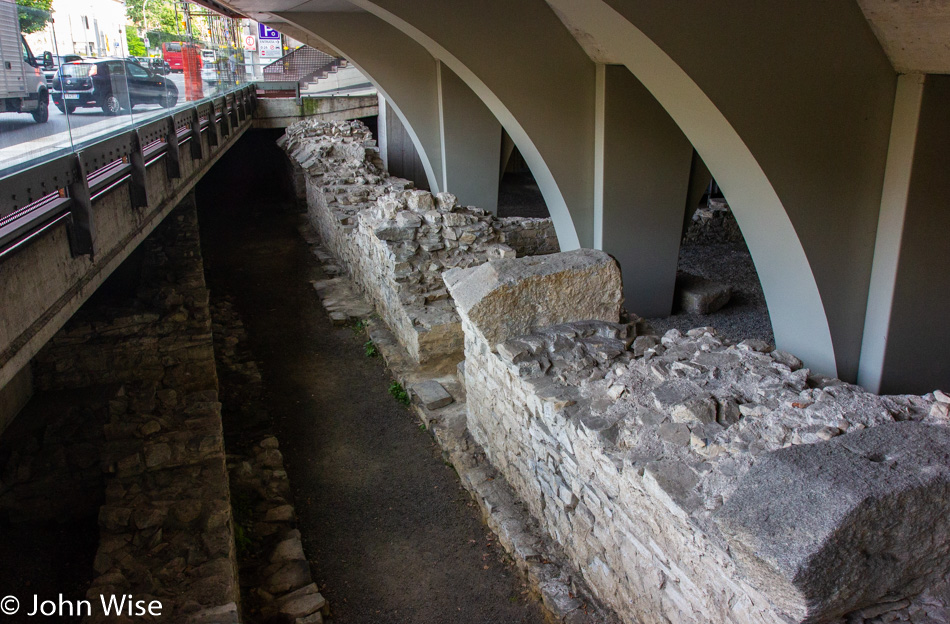
The need to build over some old Roman ruins was solved by putting the building over them on stilts so visitors could gain easy access to looking into the past.
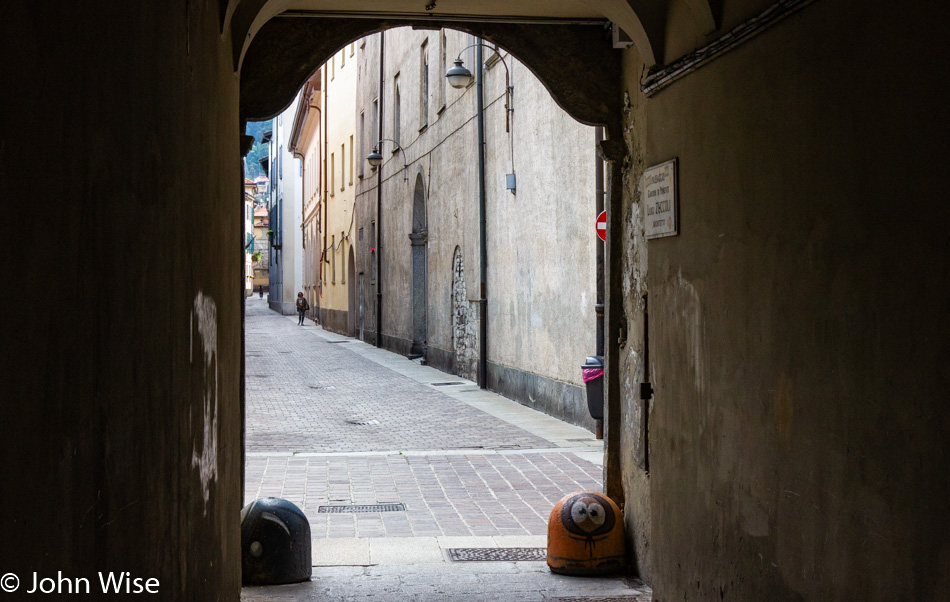
We passed through this portal several times and took a left, followed by a quick right that took us to our apartment. This time, though, we are leaving Como.
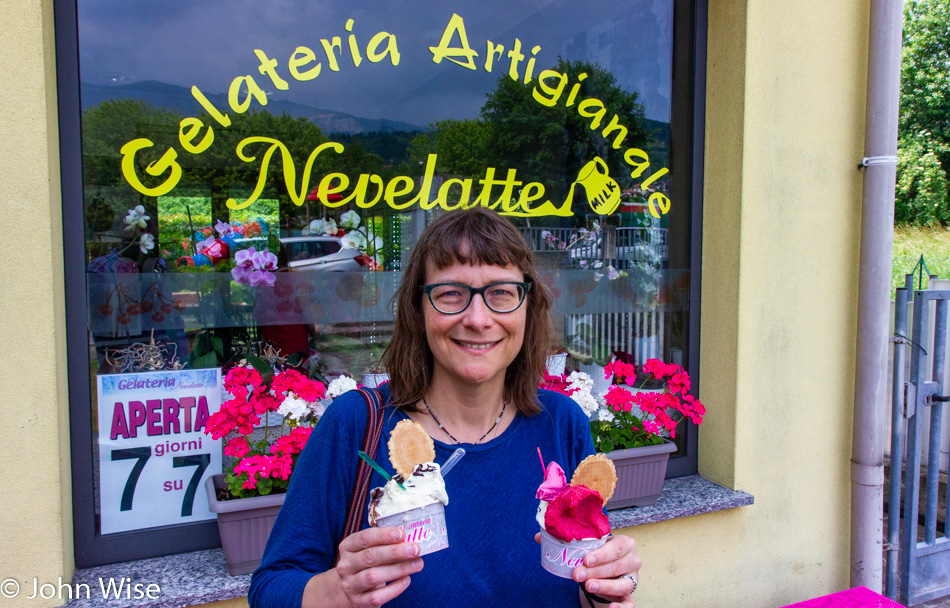
Somewhere between Como and our next destination, we needed to stop for an espresso, and right next door was a gelato shop; seemed the perfect combo for waking up to us, too. By the way, there’s a lot more anxiety in dealing with the language barrier than actual reality in getting what we need. Even where no one speaks English, like in this shop behind Caroline, we were able to make our desires understood. Pointing and grunting always works, and saying “prego” and “Grazie” (please and thanks) goes a long way.
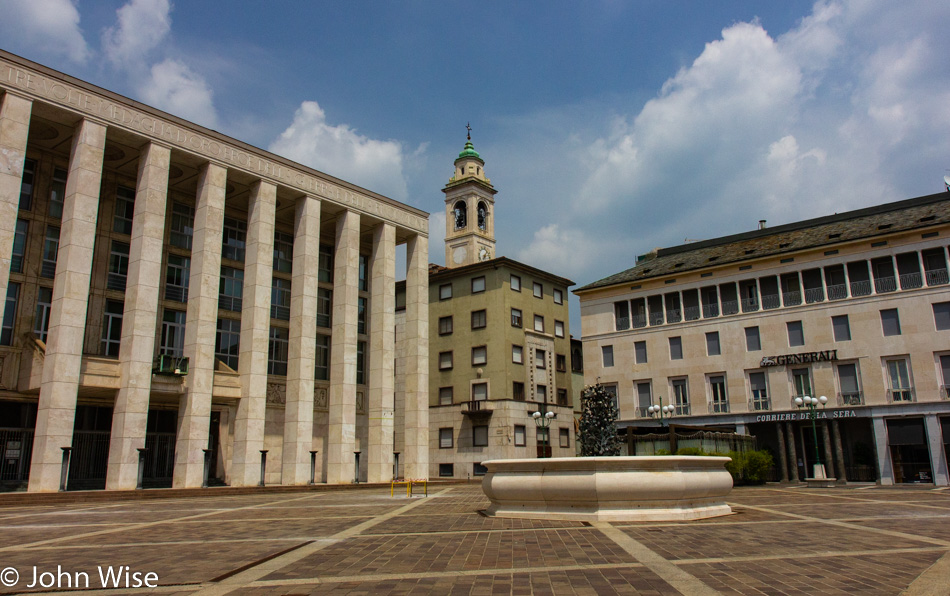
Welcome to Bergamo, Italy, though this isn’t the part of the city that most people come here to visit. It is here where we found a parking garage, and we ALWAYS park in garages while in Europe as we are fully aware that our license plates not only show we are from another country it also has a rental car sticker on it, so anyone looking at our car might assume we are visitors and that we just might have something of value in the car.
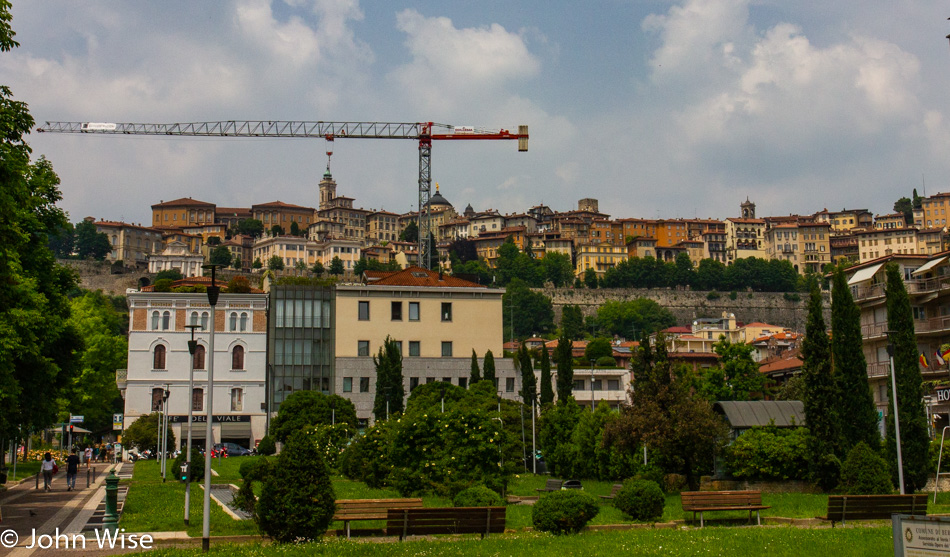
We are heading up the hill, and no, we did not opt to ride the funicular, even though Europe is going through a heatwave and we are melting.
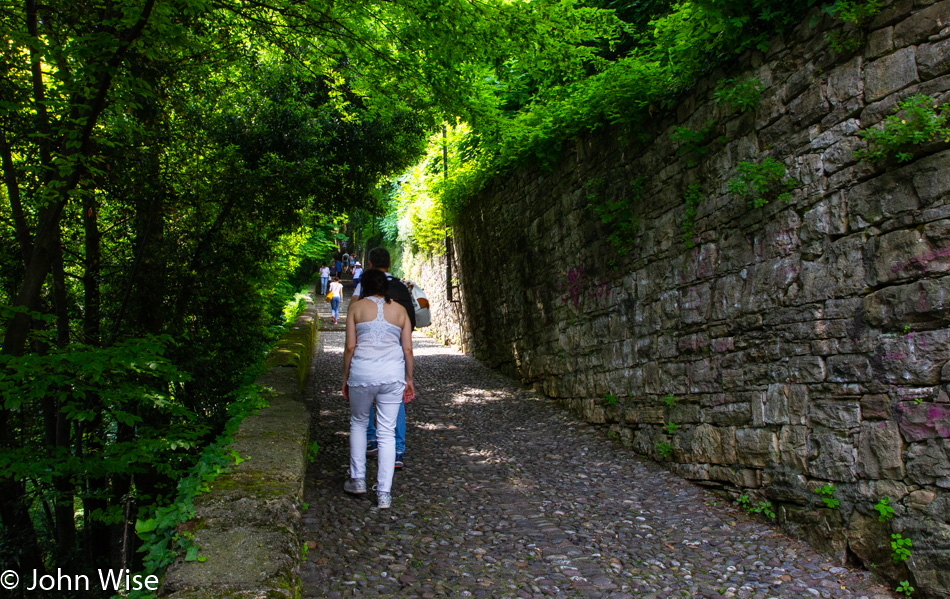
It may not look steep, and maybe it’s not that steep, but it is a long walk, and you gain about 85 meters or 28 floors on the way up.

Still going up, but now we are in the oppressively hot sun and, worse, the killer humidity that desert dwellers are unaccustomed to. Who knew the body could produce so much sweat?
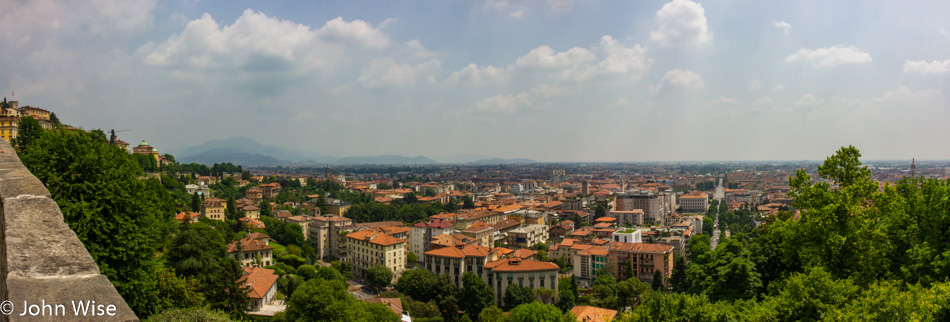
The view from up here alone could be the reason for visiting Bergamo, but there’s still so much more to come.
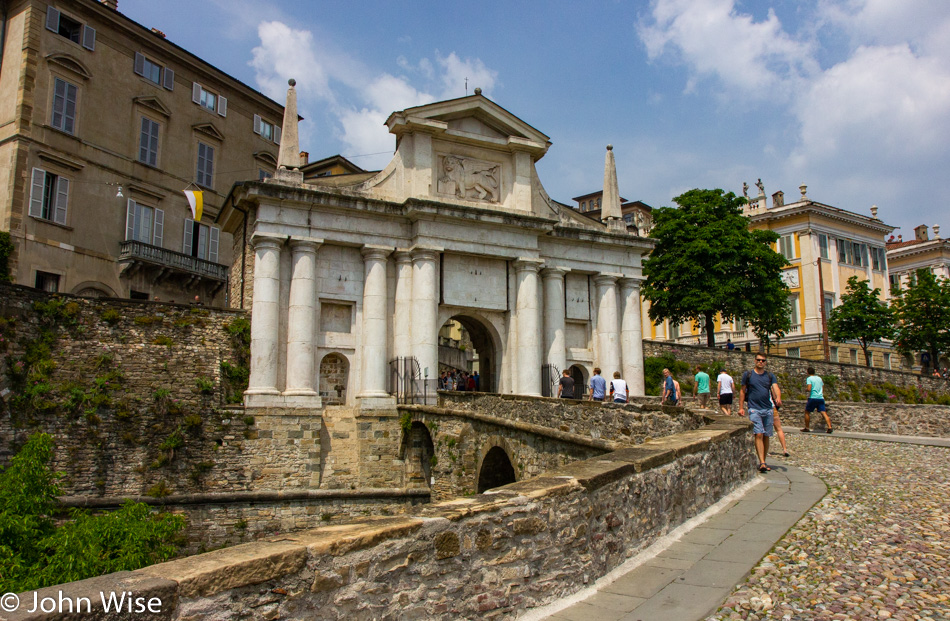
Because hilltop villages should always have impressive gates to pass through!

When every corner presents another spectacular view, the blog entry can start to get a bit long, so it goes.

I did have a photo of Caroline and I reaching the village up here, but let’s be serious: we are both sweating like pigs, and I’m looking like a lobster with sweat rolling over my forehead. So instead, I offer you this view of having to go higher yet. I’d like to add that as we passed through the gate, we had to contend with barriers and security personnel. When we asked one of the attendants what this was all for, we were informed that in about 30 minutes, an annual historic Grand Prix event was happening. Wow, did we time this correctly?

If you go up, you inevitably also go down.

Italians = shopping, god, food, and probably not in that order.
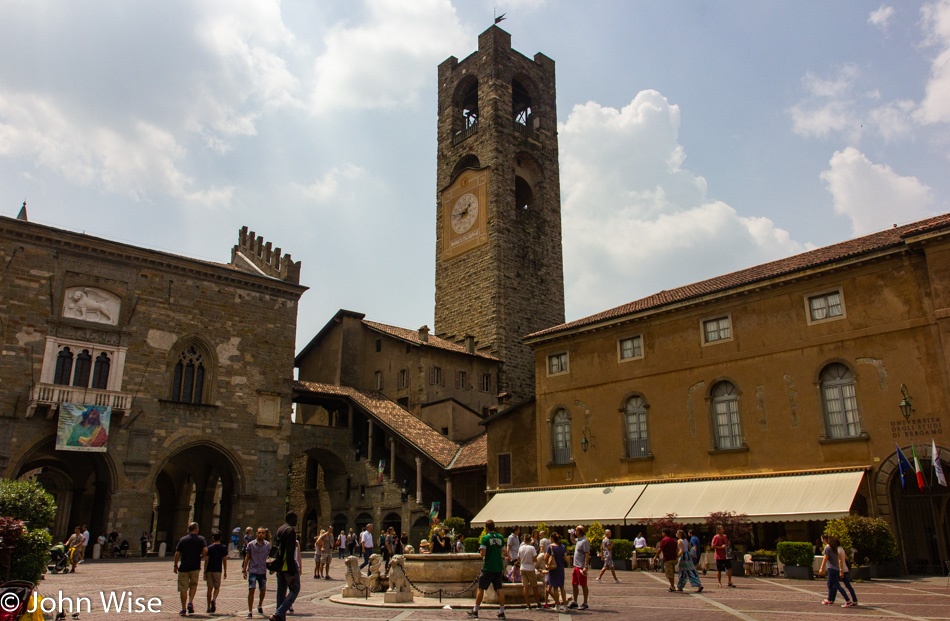
Making conscious decisions to build and maintain livable environments, even if transportation realities hundreds of years ago made those decisions for you, still requires an effort in these times to maintain aging infrastructures that do more than just attract visitors. These types of gathering places add to a quality of life that no mall will ever deliver.

You can consider this the church version of the drinking game: we see a church, and we have to go in. This is the St. Maria Maggiore Church of Bergamo, Italy, where construction began in 1137 and remains unfinished.
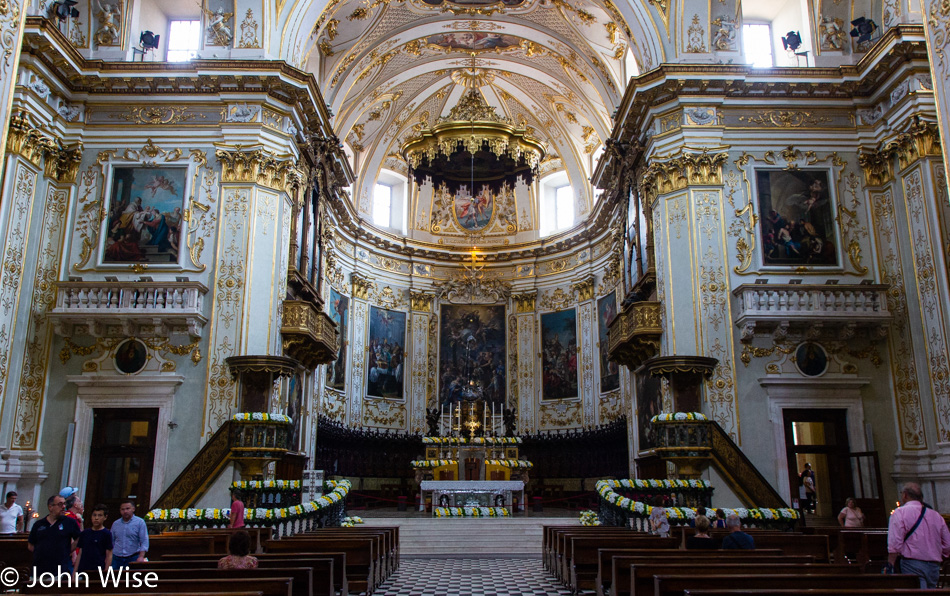
Looks finished to my untrained eye, but then again, I don’t know the exact specifications of what architectural elements go into a church or cathedral of these sizes to understand when the church itself considers one of these complete. Something else I fail to understand is that these places of worship do not charge an entry fee to visit them and thus must be funded either by the church alone or with help from the state. Considering that we in the States seem to have problems funding highways, bridges, schools, public healthcare, and we certainly don’t pay for churches, just where do our tax dollars go? Don’t go thinking I believe monies should go to the church, as I’m an atheist; I’m suggesting that I, for one, am willing to pay a few Euros to enter these historically and culturally important places and appreciate the donation boxes asking for help with renovations or maintenance.
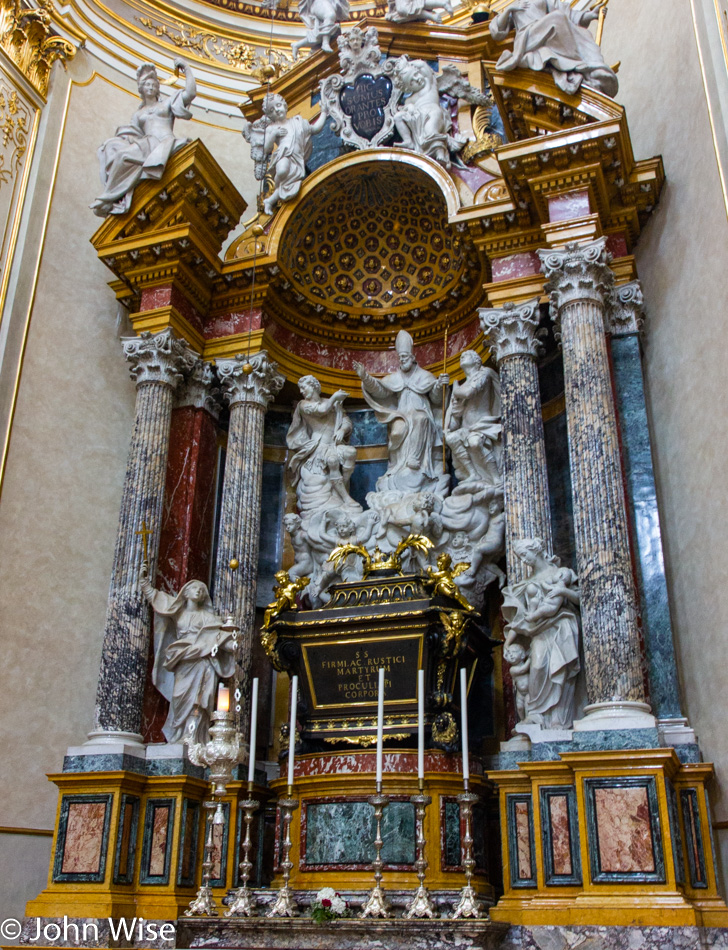
Taking these photos can be troublesome as lighting is not ideal, and I have to push the ISO and more times than not, set my aperture using a window or other relatively bright light source and then shoot the image. Still, I’m often looking for something to brace myself against to add some stability, as the shutter can be very slow, even down to half a second long.
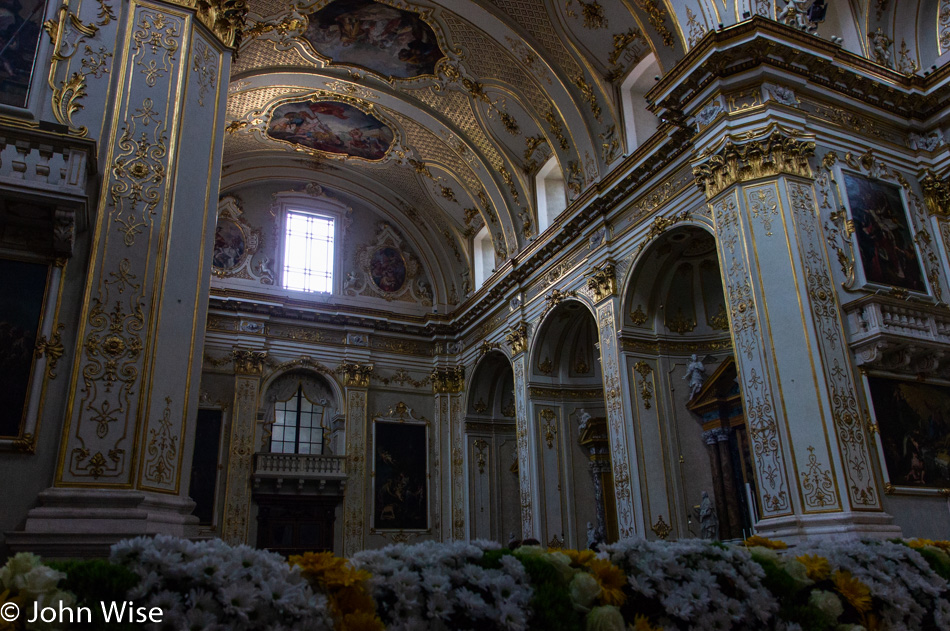
That window above would have been my light source to set the shutter speed, and with it, I still have to try to find a compromise with the aperture due to if it’s too large, I get too much depth of field, but hand-holding these shots are seriously difficult. First, stop breathing, next, be conscientious about my hands and remember that the shutter too will create a vibration, and then shoot three or four shots with the hope that one will be clear enough for my blog. When this process works, I see colors and details in these locations that cannot always be seen with the naked eye.
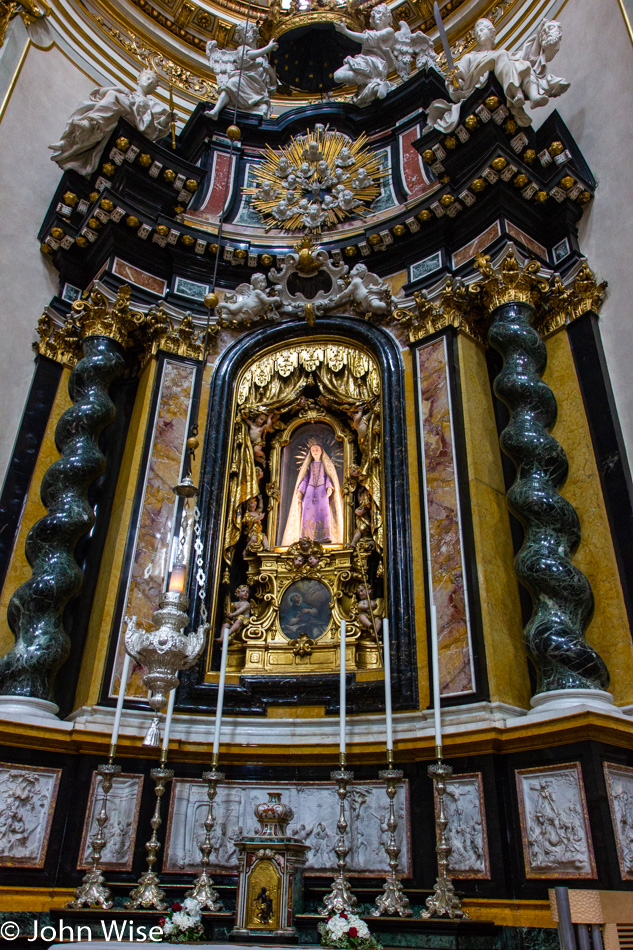
In posting these images with such low resolution for visitors, I hope that the combination of sheer beauty and a bit of narrative that demonstrates what can be visited in a single day by a couple of people who are now in their 50s will inspire others to recognize that they should make an effort to realize their dreams of visiting places that require some determination.
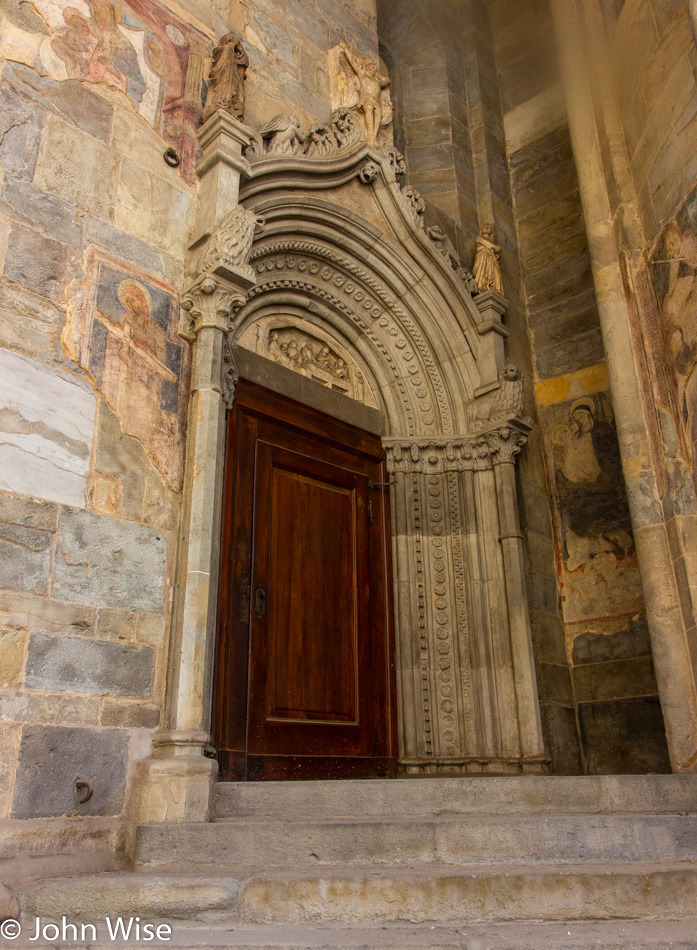
This door was in the shadows when I shot it, and the back wall was dark enough that the image of Mary and Baby Jesus wasn’t seen by me as we were walking by, and I was struck by the colors of the stonework in contrast to the deep reds in the old door. The magic of shooting images in the RAW format offers incredible surprises when editing the photos after returning home.
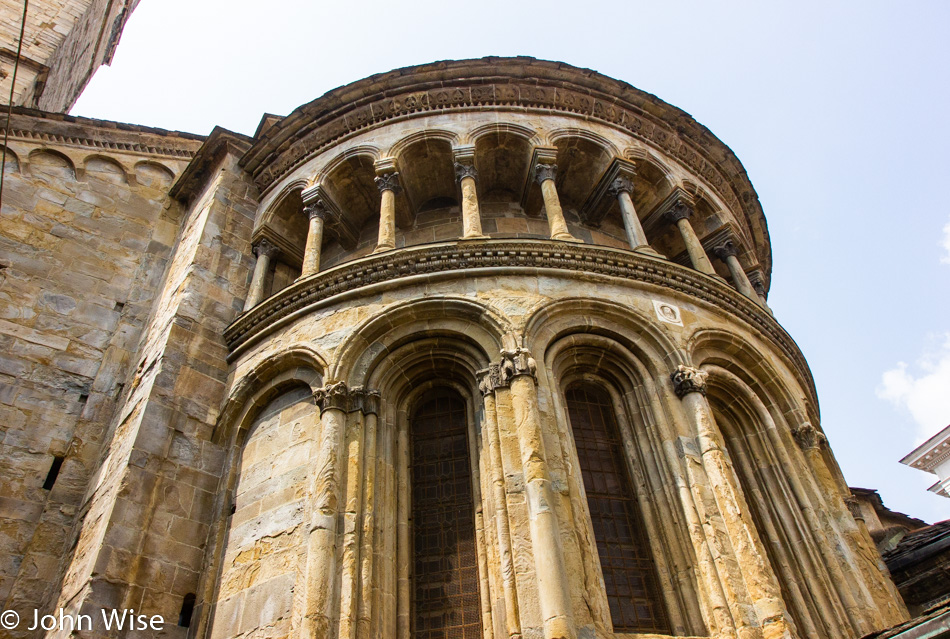
This is still part of the church, and if we’d had another hour to spend here exploring just the exterior, I’m certain I could have found another one hundred angles to shoot photos of that I would have found appealing. Consider for a moment that never before has this particular angle ever been shot from precisely this height, with this lighting, at this time of year, and the church would never have had the exact amount of wear, so although this place might be photographed millions of times a year now it is unlikely any two images will ever be quite the same.
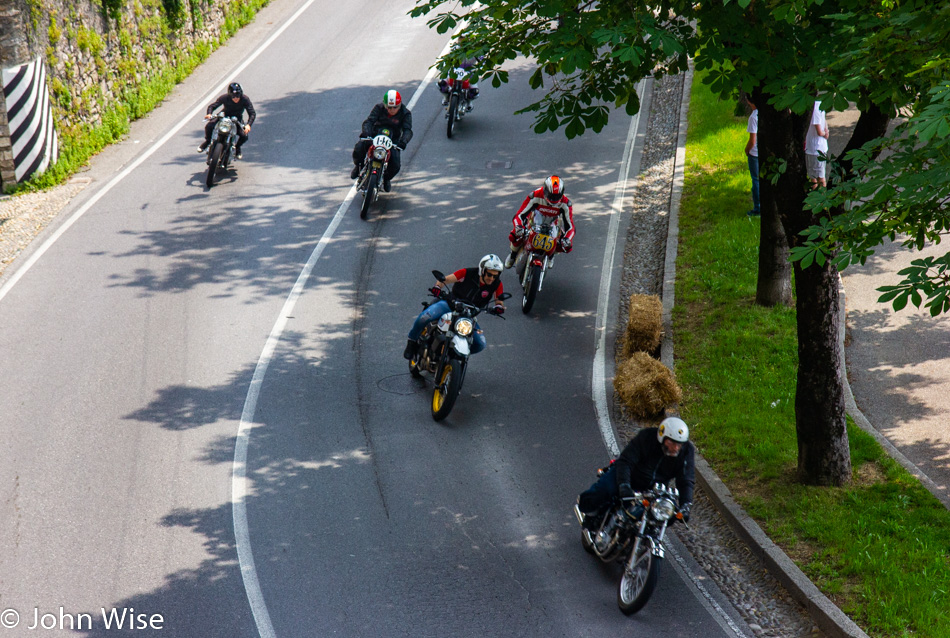
When we exited the church, we could hear that the race around the mountain had already begun, so we hoofed it over for a vantage point, and our first sight of the racers was these motorcycles. The sound was deafening, and quickly, Caroline found that she was enjoying this spectacle a lot more than she thought she would; she was all smiles.
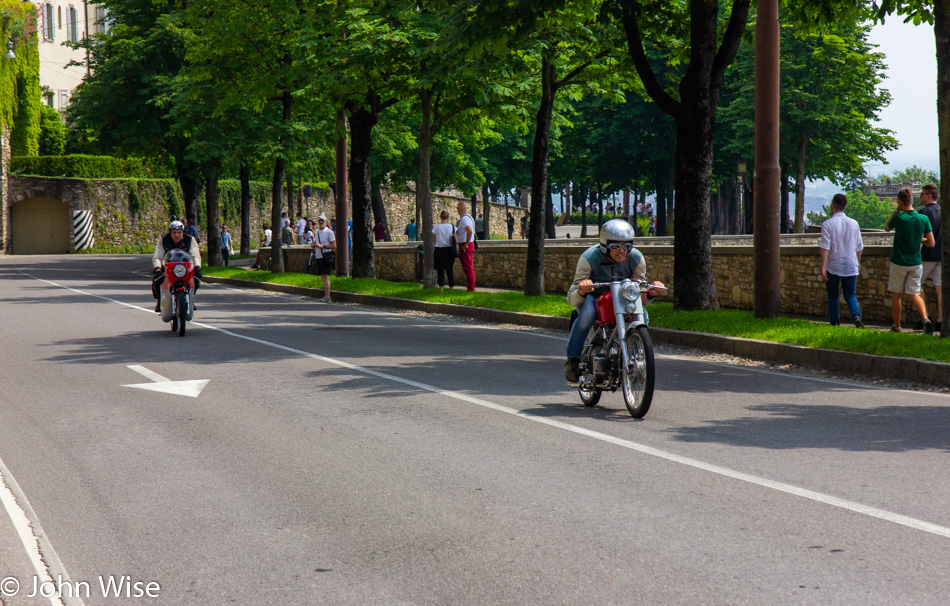
As the Grand Prix continued, we moved locations and were a bit shocked by how few people had turned out for the annual event until we rounded a particular corner near the starting line and found a sea of humanity. Some of the riders looked like they were right out of the ’20s.
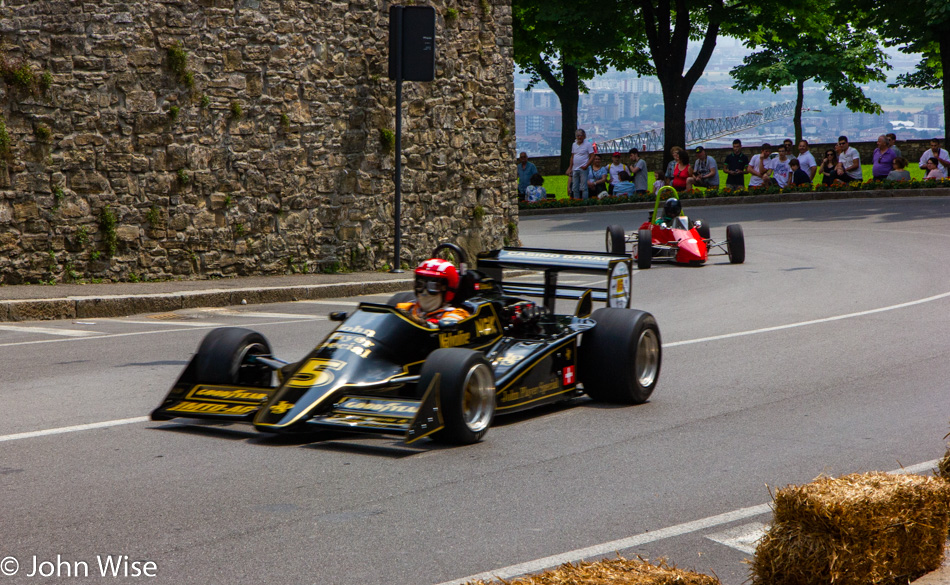
And then it was time for the cars. We don’t know the criteria for this particular Grand Prix event, but it seems like if a particular type of car or bike had been used for Grand Prix racing at some time in the past, it was qualified to show up here in Bergamo to take a couple of laps on the closed streets and speed by just inches away from us spectators.

Church of St. Agata.

While the Church of St. Agata is not as big and is a little scuffed around the edges, maybe it’s not as ornate either, but the overall impression and beauty seen between the gold, green, blues, and purples contrasted against the dark woods leave the visitor with the same sense of majesty and awe.
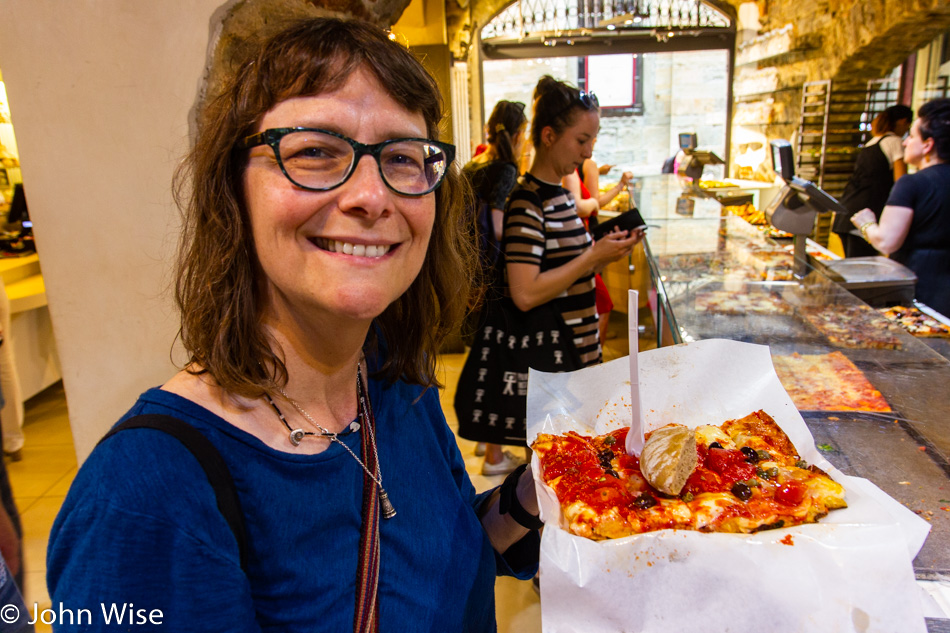
We are in Italy, so it’s always a good time for more pizza. This small shop probably featured more than a dozen varieties of the dish. After taking our 1-pound (500kg) super-slice to the oven, they would pull it out nicely warmed and then, with big scissors, slice it into bite-size pieces; of course, “bite-size” ideas may vary between diners.
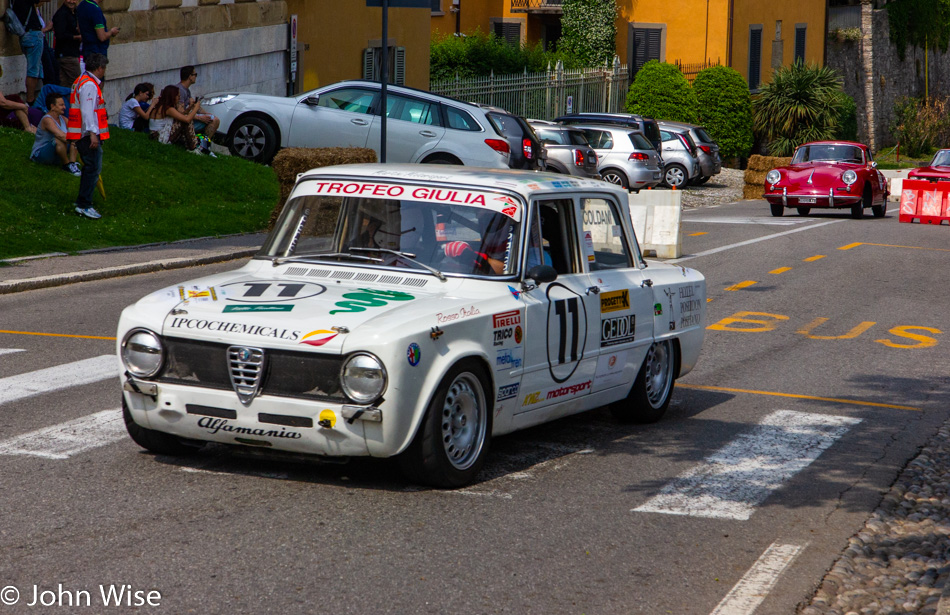
And then it was time to leave Bergamo. Our visit was short, and there were a few other things I could have shown here, but this day is already featuring more photos than I typically post with an entry. Making our way back to the trail to leave the top of the city, we had to dart across the street while there was a pause in Grand Prix traffic, and then we couldn’t help but stand here and watch a few more minutes until continuing our way to the parking garage.
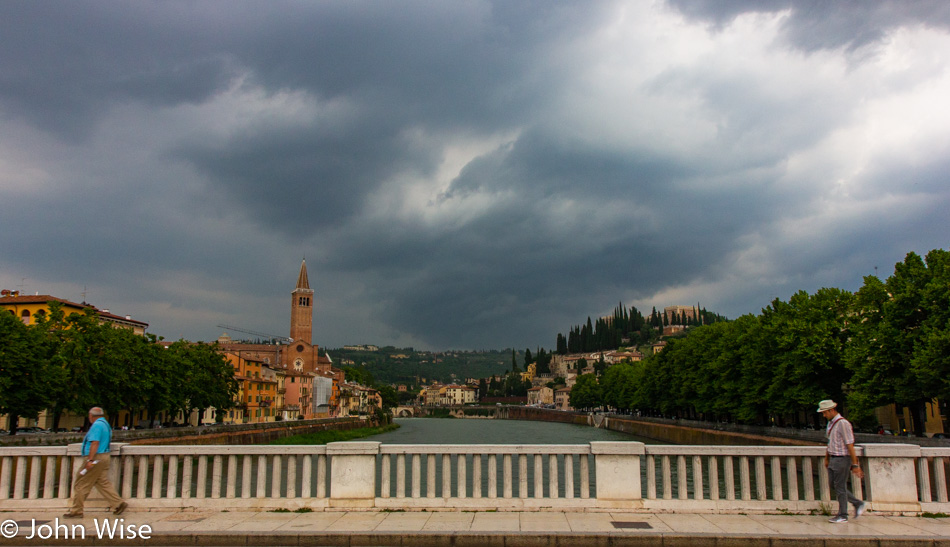
When we got to Verona, Italy, the sky suggested that it may be delivering rain in our future; lucky us, it only rained while we were eating dinner. This is the Adige River we are crossing and is the second-longest river in Italy after the Po.
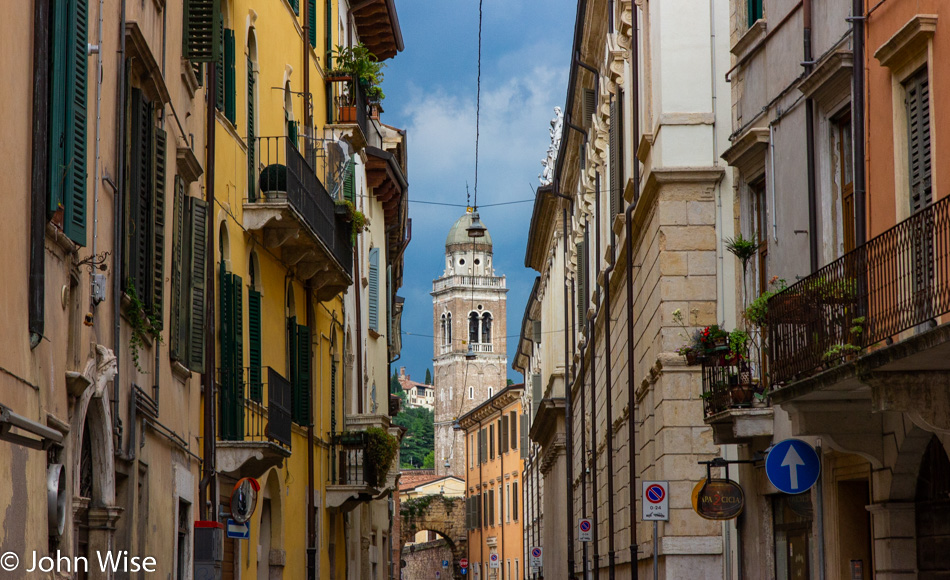
We didn’t have a lot of time to explore Verona in the light of the day before our dinner reservation, but what we did see portends great things for our day tomorrow.
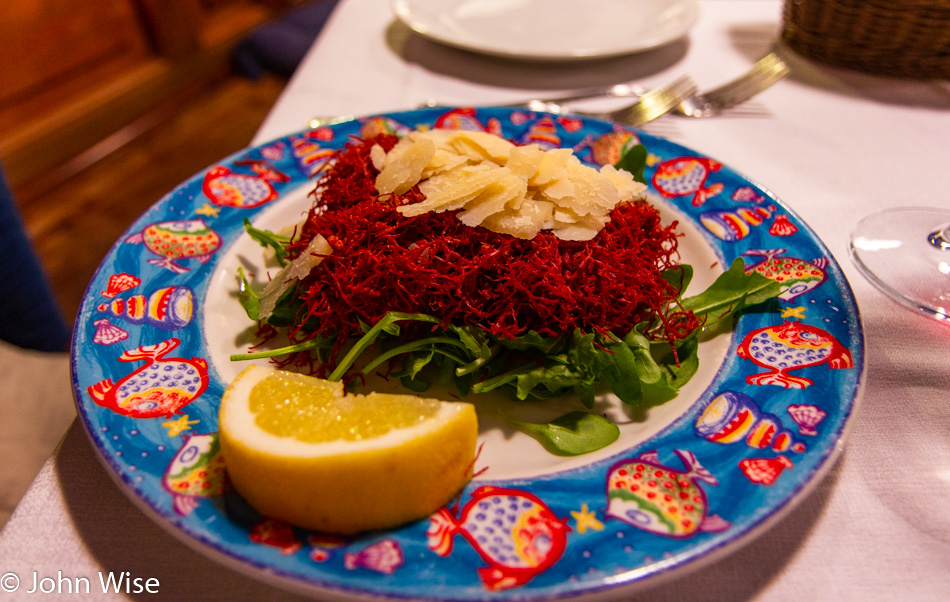
Shredded horse meat salad on arugula with shaved Parmesan from La Taverna Di Via Stella restaurant. My photo of the veal nerves with beans and onions didn’t turn out at all. Both dishes were interesting and enjoyed by both Caroline and myself.
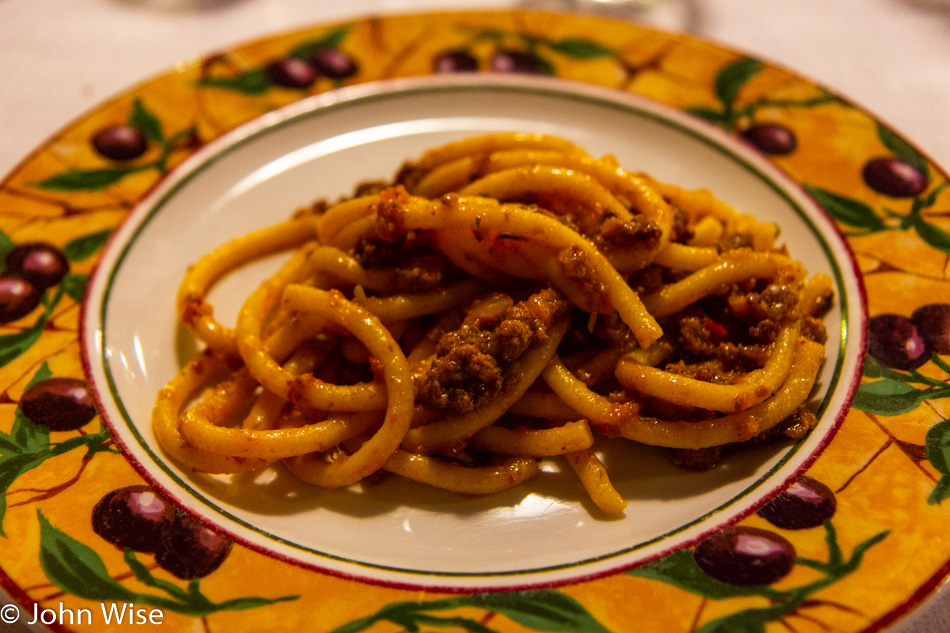
Turns out that donkey, when ground, looks just like any other ground meat. It doesn’t taste any different than any other red meat when prepared as a Bolognese. Would we eat nerves, horse, and donkey again? Yes.
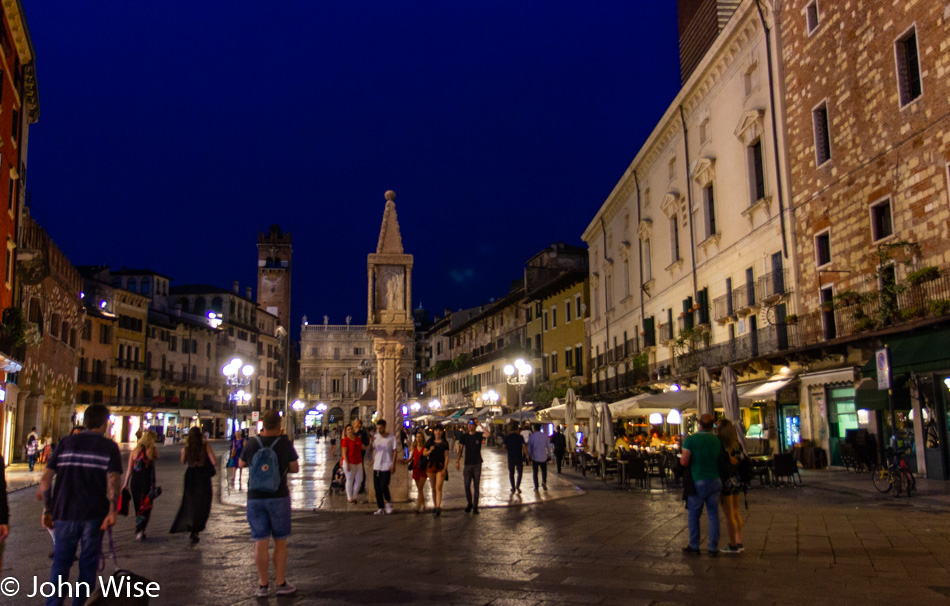
Italian squares at night are proving to be very attractive and lively places.
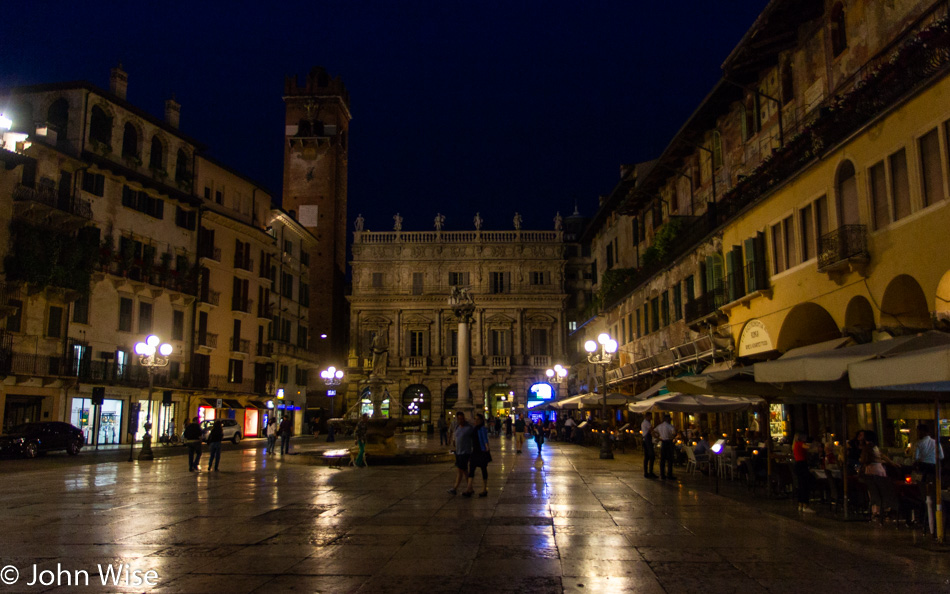
The same piazza just further along on our walk around Verona after dinner.

All cities should prominently feature lion statuary, and if they have wings, that’s all the better.
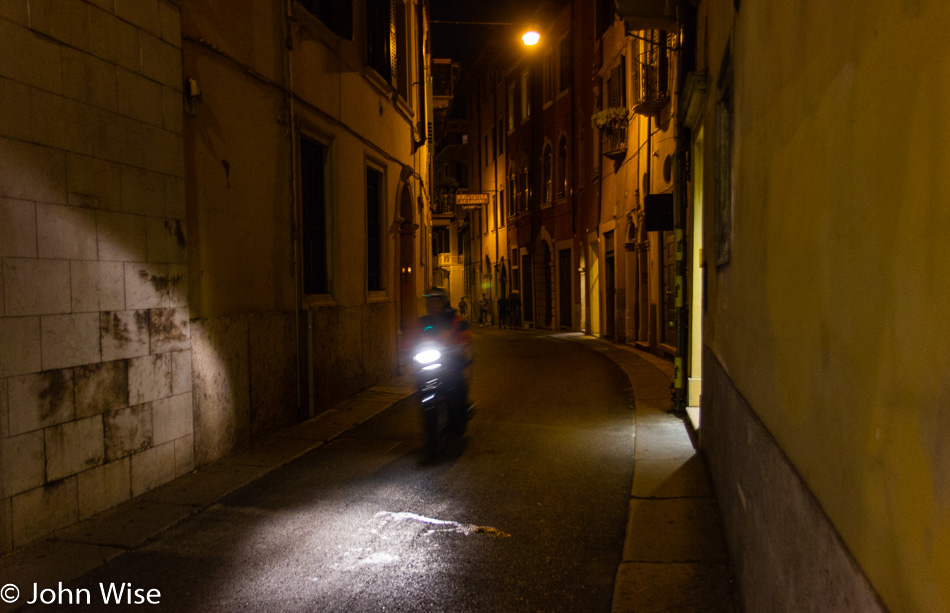
As we approach 10:00 p.m. we have walked 10.6 miles (17 km) and climbed 44 floors of elevation over the course of the day.
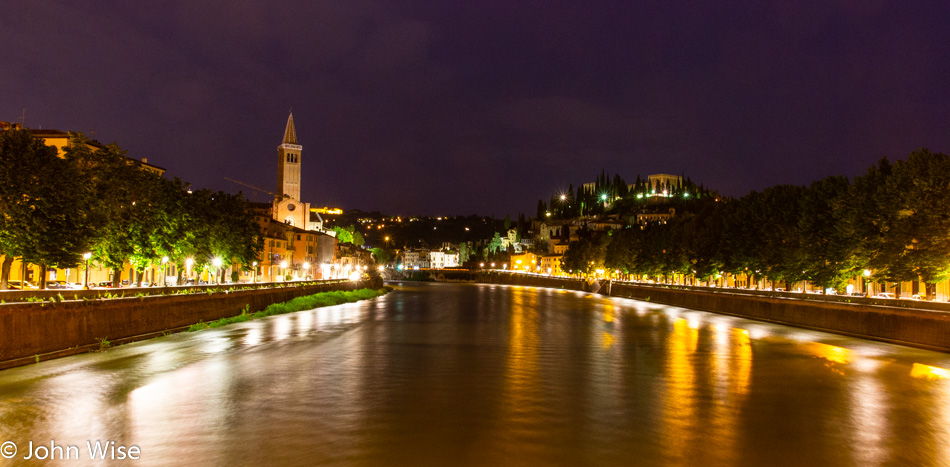
When wandering a city with this kind of exquisite beauty, it’s difficult to call it quits for the day, but our feet are getting sore, and we are genuinely tired. Time to turn into our Airbnb apartment, just another couple of minutes away from the Adige River.